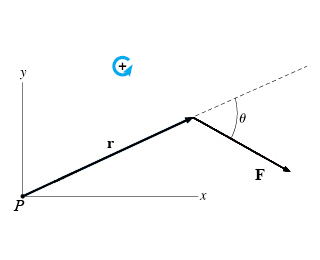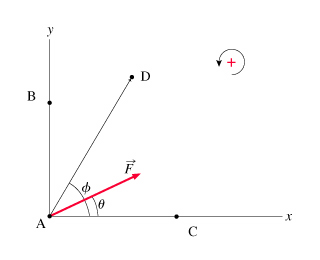The tangential force method involves finding the component of the applied force that is perpendicular to the displacement from the pivot point to where the force is applied. This perpendicular component of the force is called the tangential force.
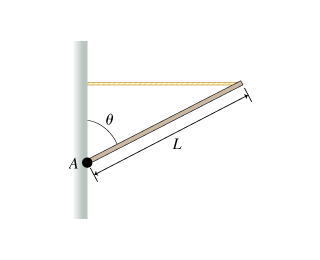
(a) What is  , the magnitude of the tangential force that acts on the pole due to the tension in the rope?
, the magnitude of the tangential force that acts on the pole due to the tension in the rope?
Express your answer in terms of  and
and  .
.
When using the tangential force method, you calculate the torque using the equation
 ,
,
where  is the distance from the pivot to the point where the force is applied. The sign of the torque can be determined by checking which direction the tangential force would tend to cause the pole to rotate (where counterclockwise rotation implies positive torque).
is the distance from the pivot to the point where the force is applied. The sign of the torque can be determined by checking which direction the tangential force would tend to cause the pole to rotate (where counterclockwise rotation implies positive torque).
(b) What is the magnitude of the torque  on the pole, about point A, due to the tension in the rope?
Express your answer in terms of
on the pole, about point A, due to the tension in the rope?
Express your answer in terms of ,
,  , and
, and  .
.
The moment arm method involves finding the effective moment arm of the force. To do this, imagine a line parallel to the force, running through the point at which the force is applied, and extending off to infinity in either direction. You may shift the force vector anywhere you like along this line without changing the torque, provided you do not change the direction of the force vector as you shift it. It is generally most convenient to shift the force vector to a point where the displacement from it to the desired pivot point is perpendicular to its direction. This displacement is called the moment arm.
For example, consider the force due to tension acting on the pole. Shift the force vector to the left, so that it acts at a point directly above point A in the figure. The moment arm of the force is the distance between the pivot and the tail of the shifted force vector. The magnitude of the torque about the pivot is the product of the moment arm and force, and the sign of the torque is again determined by the sense of the rotation of the pole it would cause.
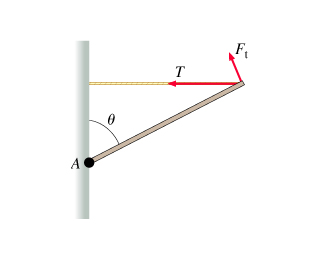
(c) Find  , the length of the moment arm of the force.
Express your answer in terms of
, the length of the moment arm of the force.
Express your answer in terms of and
and  .
.
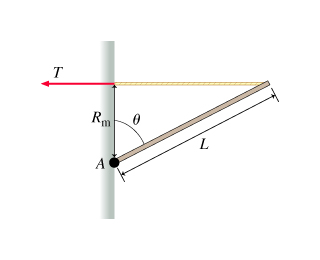
(d)Now consider a woman standing on the ball of her foot as shown. A normal force of magnitude  acts upward on the ball of her foot. Achilles' tendon is attached to the back of the foot. The tendon pulls on the small bone in the rear of the foot with a force
acts upward on the ball of her foot. Achilles' tendon is attached to the back of the foot. The tendon pulls on the small bone in the rear of the foot with a force . This small bone has a length
. This small bone has a length  , and the angle between this bone and the Achilles' tendon is
, and the angle between this bone and the Achilles' tendon is  . The horizontal displacement between the ball of the foot and the point P is
. The horizontal displacement between the ball of the foot and the point P is  .
.
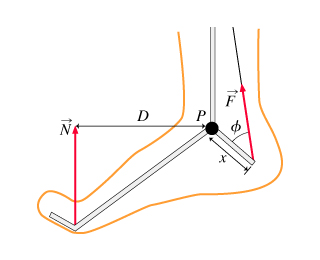
Find τp, the torque about point P due to the force applied by the Achilles' tendon. Express your answer in terms of F, ϕ, and x.
The tangential force method involves finding the component of the applied force that is perpendicular to the displacement from the pivot point to where the force is applied. This perpendicular component of the force is called the tangential force.
(a) What is , the magnitude of the tangential force that acts on the pole due to the tension in the rope?
When using the tangential force method, you calculate the torque using the equation
,
(b) What is the magnitude of the torque
The moment arm method involves finding the effective moment arm of the force. To do this, imagine a line parallel to the force, running through the point at which the force is applied, and extending off to infinity in either direction. You may shift the force vector anywhere you like along this line without changing the torque, provided you do not change the direction of the force vector as you shift it. It is generally most convenient to shift the force vector to a point where the displacement from it to the desired pivot point is perpendicular to its direction. This displacement is called the moment arm.
For example, consider the force due to tension acting on the pole. Shift the force vector to the left, so that it acts at a point directly above point A in the figure. The moment arm of the force is the distance between the pivot and the tail of the shifted force vector. The magnitude of the torque about the pivot is the product of the moment arm and force, and the sign of the torque is again determined by the sense of the rotation of the pole it would cause.

(d)Now consider a woman standing on the ball of her foot as shown. A normal force of magnitude

